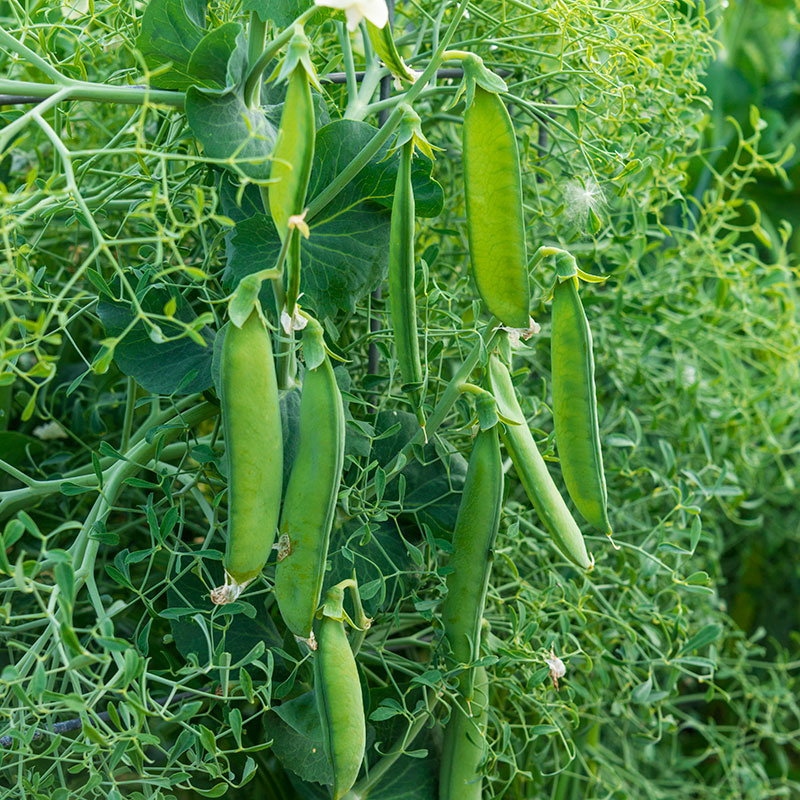While most of our vegetables and herbs are grown to be eaten, some are grown instead to simply decorate or garnish a plate. Yes, you can eat the fluffy parsley or the wavy kale, but most don't. So what if you can grow a truly delicious garnish? One that is striking, not only in its unusual appearance, but its light, delightful flavor?
You can grow peas (Pisum sativum) to garnish the plate; not the peas themselves, but rather the vines, leaves, flowers and tendrils.
The aptly named parsley peas are a variety of snap peas grown for their delicious, tender tendrils, leaves, stems and flowers.
You can cut individual branches or just harvest the whole plant at any stage, but best when they are just six to eight inches tall. For a cut-and-come-again harvest, cut the stems from the mother plant above the first node on the main stem - you will get a second flush of growth and another harvest.
Since you are growing these for the foliage rather than waiting for peas to develop, you will get lots of edible greens in just 30 days. Of course you can leave some flowers to develop into peas and get snap peas in 70 days. The vines, if left to grow along, will eventually reach three feet long.
Parsley pea seeds are available from West Coast Seeds (www.westcoastseeds.com).
For an even more shocking pea, try the purple-podded Sugar Magnolia Tendril Pea.
This is another sugar snap pea with lots of edible tendrils, but if left to grow on, it will eventually yield peas with purple pods. These sugar snap peas are thicker and plumper than regular snow peas; more like green beans except these have old-fashioned dusty blue pods hiding in beds of green foliage.
The Sugar Magnolia Tendril Pea vines are vigorous, often growing to eight feet tall, so if left to grow will require a trellis. As an added bonus the plants even have purple flowers. Those pretty purple flowers along with the leaves and tendrils are all edible, with a true pea flavor.
Feisty pea is another pea grown for its foliage, and has the highest tendril count of any pea. The super-sweet, medium-sized peas average six to eight per pod. Feisty peas have upright vines that are only 30 inches long, so they do not need trellising.
Feisty grows lots of edible tendrils, yet remarkably few leaves. The absence of leaves makes harvesting the three-and-a-half-inch pods easy. But it is the tendrils that are the star of the show. Use the lacy pea tendrils as garnish or add to stir-fries and salads for a delicate pea flavor. Feisty is very resistant to many diseases such as fusarium wilt race 1, and even has some resistance to powdery mildew.
All peas grow best in cool weather, so summer crops may yield less than spring or fall crops. Peas grow best with a soil pH of 6.0-7.5.
Plant your early peas as soon as the soil can be worked in the spring, though these varieties can be sown almost any time because you don't really care about the peas, but the foliage. Plant the seeds in well-drained soil, planting one to one-and-a-half inches apart, one to one-and-a-half inches deep, about 25 seeds every foot in the row. To encourage good germination, keep the peas well watered.
You can also plant these in pots or raised beds and get great yields because you are harvesting the entire plant. Always inoculate pea seeds to encourage the formation of nitrogen-producing nodules along the roots. This nitrogen fixation fertilizes the soil, resulting in larger plants and higher yields.
To avoid diseases try to always plant in well-drained soil and rotate crops at least every three years.
With about 2,200 seeds per pound, 250 seeds will sow eight feet of row and a pound will plant about 80 feet of peas.
Many pea seeds are treated so they are less likely to rot in wet, cold soil, but you can usually opt for non-treated seeds or those treated organically. For a fall crop, sow directly in the garden in late August through September.
Because almost all peas are open pollinated (non-hybrid), you can save your own seeds for next year.
Pot up some tendril peas and you will have greens for stir-fries and salads, or to simply garnish a plate with something unusual yet tasty.





















































